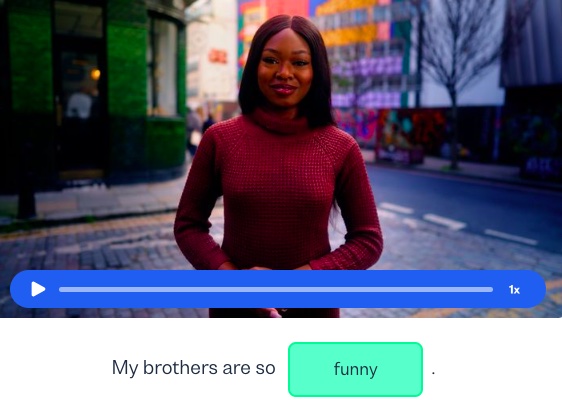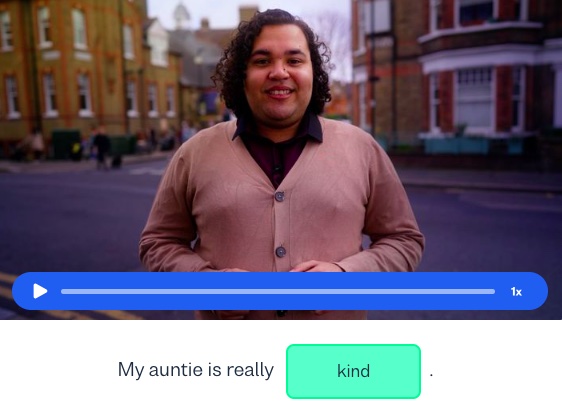A Guide to Descriptive Adjectives in English
Learn how to add color and style to your vocabulary with the help of descriptive adjectives.
I want to learn...
Descriptive adjectives are the key to describing the people, places and things (and animals!) in the world around us. Without them, it’d feel like we were observing a dull painting with hardly any colors in a museum. But when you use descriptive adjectives, your words come to life. As an example, try to picture the person described below:
She was beautiful, with long, curly hair almost completely hidden by an enormous cowboy hat. She seemed to be distracted and completely uninterested in what I was saying.
Can you picture this person easily? You might notice we already used several descriptive adjectives for people, such as curly to describe her hair, enormous to describe her hat, and distracted to talk about her mood.
In this article, we’ll dive into different kinds of descriptive adjectives, learn how and when to use them, and discover how to distinguish them from other types of adjectives.
Reviewing adjectives
Here’s a quick recap of adjectives. Adjectives are among the eight parts of speech in English, which include pronouns, nouns and verbs. We use adjectives to describe or modify nouns, pronouns, and noun phrases. Consider the different adjectives in the sentences below:
- Patty is a friendly dog.
- Patty is a funny dog.
- Patty is a strange dog.
As you can see, by using three different adjectives (friendly, funny and strange), we can describe Patty the dog in three completely different ways.
In English, adjectives usually come before the noun they modify (a friendly dog). Adjectives can come after the noun if they follow a linking verb, such as be, seem, or look. (For example, “My neighbor’s dog is friendly” and “Your new haircut looks amazing.”) This differs from other languages, such as French and Spanish, where adjectives almost always come after nouns.
There are between eight and 13 different types of adjectives in English, depending on which dictionary or linguist you consult. Here are some examples from the most common and frequently used categories:
- Descriptive: boring, funny, loud, quiet
- Demonstrative: this, that, these, those
- Possessive: my, your, his, her, our, their
- Interrogative adjectives: whose, what, which
- Quantifying adjectives: many, some, few, couple, any, all, several
- Cardinal numbers: one, ten, thirty, one million
- Ordinal numbers: first, fifth, sixteenth
To learn more about adjectives and other parts of speech, check out our detailed guides on how to use English parts of speech, nouns, and pronouns.
What’s the deal with descriptive adjectives?
As their name suggests, descriptive adjectives describe the characteristics and qualities of people, places, things and animals. Thanks to descriptive adjectives, we can understand that jalapeño peppers are spicy, the weather is sunny outside and the neighbor’s dog is playful.
In other words, descriptive adjectives provide essential information – without them, we wouldn’t have anything (besides our imaginations!) to describe nouns.
We can further divide descriptive adjectives into the categories in the table below:
Types of descriptive adjectives
| Simple adjectives | Compound adjectives | Proper adjectives | Comparative adjectives | Superlative adjectives |
|---|---|---|---|---|
| bored | easily distracted | French | bigger | biggest |
| excited | hard-working | Peruvian | faster | fastest |
| dangerous | quick-thinking | Roman | stronger | strongest |
| quiet | world-famous | Greek | tastier | tastiest |
Simple adjectives
‘Simple adjectives’ are probably the most common adjectives you’ll come across, and they’re, well… simple because they always consist of only one word. For instance, you might talk about a delicious sandwich, a difficult task or a relaxing vacation.
One useful way to practice these adjectives is by breaking them down further into the categories where we’ll most likely use them. For instance, we could split descriptive adjectives into words used for describing food, personality, physical appearance, landscapes or even travel destinations.
Consider the examples in the chart below:
Categories of simple adjectives
| Food | Personality | Physical appearance | Landscapes |
|---|---|---|---|
| bittersweet | outgoing | short | flat |
| spicy | shy | tall | steep |
| salty | talkative | muscular | desolate |
Compound adjectives
Compound adjectives are formed from two or more words, often two adjectives. The combination of words doesn’t matter, as long as the two words work together to serve as an adjective. Notice the examples in the following sentences:
- My partner and I were in a long-distance relationship before we moved in together.
- There are more than 500 million Spanish-speaking people in the world today.
- We complained to our server because our chicken was overcooked.
Compound adjectives are a separate universe in their own right. However, this chart should give you an idea of the variety of compound adjectives, plus some commonly used ones (just like commonly used, which is itself a compound adjective).
| Parts of Speech | Examples |
|---|---|
| Adjective + noun | fast-food, deep-sea, long-distance |
| Adjective + verb (present participle) | Spanish-speaking, hard-working, slow-moving |
| Adjective + verb (past participle) | open-minded, short-lived, deep-fried |
| Noun + verb (present participle) | time-consuming, life-changing, eye-catching |
| Noun + verb (past participle) | fire-damaged, snow-covered, heartbroken |
| Noun + noun | seaside, bird’s eye, bulletproof |
| Noun + adjective | energy-efficient, world-famous, ice-cold |
| Number + noun | nineteenth-century, first-place, third-generation |
| Adverb + past participle | easily distracted, overcooked, well-known |
Most of the time, the words that make up compound adjectives are joined by a hyphen, but this is not always true. As per the examples above, long-distance, world-famous, and life-changing contain hyphens whereas easily distracted, overcooked, and heartbroken do not.
Pro tip: Like many aspects of the English language, there are rules for forming compound adjectives. However, there are also many exceptions. You can learn these rules and exceptions by practicing new words with Busuu’s Vocabulary Trainer, but you’ll also learn them as you work on your reading skills. As you read more and more, you’ll begin noticing patterns in the meanings and forms of different categories of words, and soon enough, recognizing and using these words will feel more natural.
Proper adjectives
Here in Madrid, I have several friends whose kids speak English and Spanish. This is because, in most cases, their mothers are from the US while their fathers are from Spain. We use the word American to describe the mother’s nationality and Spanish for the father’s nationality. American and Spanish are examples of proper adjectives.
Proper adjectives refer to things like one’s country or region of origin, ethnicity and religion. We also use proper adjectives to describe historical periods. They are always capitalized, so they are relatively easy to identify.
Here’s a nifty chart with some more examples:
Examples of proper adjectives
| Country of origin | Religion | Historical period |
|---|---|---|
| Australian | Christian | Neolithic |
| Chinese | Jewish | Medieval |
| Vietnamese | Muslim | 19th-century |
Comparative and superlative adjectives
Comparative adjectives compare one person, place, thing or animal against another with the same characteristic or quality. For example:
Tigers are more dangerous than house cats.
Superlative adjectives are also used to make comparisons, except they compare something or someone against everything else with that same characteristic or quality. For example:
Cheetahs are the fastest animals in the world.
How do we know when to use a comparative or superlative descriptive adjective?
Let’s consider our earlier example with tigers. Would you say tigers are better at being dangerous than, say… house cats? Your kitty might have given you an unexpected scratch now and then, but likely you wouldn’t last long in an encounter with a tiger out in the wild. Therefore, it’s reasonable to use the comparative form and say that tigers are more dangerous than house cats.
As for cheetahs…. Let’s compare them to as many other wild animals as we can. Are cheetahs faster than, for example, elephants, crocodiles, spiders and whales? Instead of saying that cheetahs are faster than any other wild animal, we should use a superlative adjective and say that cheetahs are the fastest animals in the world.
Pro tip: Comparative and superlative adjectives both follow their own special rules. Plus, there are many exceptions to the basic rules… but don’t panic! Use Busuu’s AI-powered Grammar Review to strengthen your weak points and put grammar rules into practice through engaging and personalized interactive quizzes.
Wrapping up
In this article, we’ve seen how descriptive adjectives enrich and enhance our descriptions of the world around us. We’ve explored how and when to use the different types of descriptive adjectives, such as compound and proper adjectives, and provided some tips on how to distinguish between these different types.
So the next time you see a friend or a loved one, imagine you’re a book author and try thinking of some descriptive adjectives you might use to describe them. You’ll be surprised at how adjectives can make life seem just a little more interesting!
Want to boost your vocabulary?
Practice only the words you need with Busuu’s interactive bite-sized lessons and personalized review quizzes. Get plenty of feedback and support from fluent English speakers in Busuu’s community of more than 120+ million learners.

